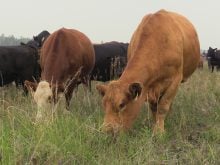This cattle market information is selected from the weekly report from Canfax, a division of the Canadian Cattlemen’s Association. More market information, analysis and statistics are available by becoming a Canfax subscriber by calling 403-275-5110 or at www.canfax.ca.
Fed market hits high
Last week the fed market traded at the highest point in seven weeks. Fed steers averaged $151.06 per hundredweight, up 25 cents from the previous week, while heifers traded at $151.05, up 80 cents from the previous week.
Read Also

Working groups established to address challenges in the containerized and bulk movement of commodities
CN is working with the pulse and special crops sector on resolving challenges in shipping those commodities.
Based off the five-year average, fed prices historically strengthen from now until the end of December. Packer margins remain positive, which should keep all plants running five days a week until the holidays.
AAA and AA cut-out values traded five percent higher than last year, while fed cattle prices were steady with last year. Two out of the three western Canadian packers were active on the cash market last week. Top-end dressed sales were reported in the mid to upper $250s per cwt. delivered.
Last week some producers negotiated sales with no weight breaks. However, bids were $2 to $4 per cwt. lower on a dressed basis, compared to sales with 1,050 pound weight breaks.
Cattle that were bought last week were being scheduled for delivery the week of Dec. 24. For the weeks ending Nov. 24 and Dec. 1, western Canadian heifer slaughter volumes totalled 19,181 head and17, 812 head, respectively.
For the second half of the year, this ranks as the first and second largest slaughter volumes. With heifer weights 19 lb. larger than last year, heifers may be staying on feed longer, and peak heifer slaughter volumes could still be ahead.
Cash-to-futures basis levels weakened from -4.06 to -7.17 per cwt., the weakest basis level seen this year. Basis levels are now weaker than the five-year average.
Canfax said the market is only weeks away from seeing more yearlings come onto the market. A lot of summer-placed yearlings have break-evens in the mid to upper $160s per cwt. for the first quarter of 2019. With fed prices in the low $150s, few if any yearlings will be sold ahead of schedule.
In the United States last week, light trade was reported in Iowa and Nebraska with dressed sales ranging from $183-$185 per cwt., steady with the previous week. By Friday, packers in the north were bidding up to $187 per cwt.
Cows steady
Prices for D2 cows rose by 35 cents last week to average $73.42 per cwt. Slaughter bulls were down by $1 to average $84.75. Prices for D3 cows firmed $2.40 per cwt. higher to average $66. Dressed cow bids trended sideways at $149-$152 per cwt. delivered.
Western Canadian non-fed slaughter for the week ending Dec. 1 was eight percent lower than the previous week at 11,012 head. Large cow slaughter is anticipated for the next couple of weeks, and supplies will be ample. Auction volumes are expected to tighten, but there are significant supplies on feed. Non-fed prices are expected to trend mostly steady until the new year.
Feeders soft
Alberta feeder prices softened last week with average steers dipping almost $4.50 per cwt. lower than the previous week. Heifer prices saw a more modest decline, trending $1.25 per cwt. lower.
Varied quality and limited demand was observed on calves less than 400 lb,. and prices slipped around $7 per cwt. lower. Calves from 600-700 lb. saw prices mostly steady to $3 per cwt. lower than the previous week.
Feeders from 600-800 lb. have seen prices steadily decline since the beginning of October, and last week steers fell another $3 lower. Similar weight heifers traded mostly $1.25-$2.75 per cwt. lower.
Feeders heavier than 800 lb. traded mixed with steers down sharply by $5.50-$7.25 per cwt. while heifers trended mostly steady to $1.25 lower.
Auction volumes plummeted 22 percent lower than the previous week to 39,760 head, and year-to-date auction volumes were two percent lower than a year ago at 1,596,510 head. The U.S. Department of Agriculture reports Canadian feeder exports to the U.S. for the holiday week ending Nov. 24 were 23 percent lower than the previous week at 3,733 head and year to date were 62 percent larger, totalling 183,700 head.
Canfax said the calf run is winding down, and volumes are expected to dwindle toward the end of the year. Feeding margins continue in the red for calves less than 750 lb., while margins on larger feeders are now trending in the black.
Cutouts steady
In U.S. beef trade, cut-out values were steady last week with light to moderate demand observed on a moderate to heavy offering. The Choice cut-out value averaged US$212.67, almost even with the previous week. Select was at $198.22.
The Canada AAA cut-out value for the week ending Nov. 23 rallied C$2.66 per cwt. higher than the previous week, and AA firmed $1 per cwt. higher. The Canadian cutout continues to trade at a significant discount to the U.S. with AAA trending $11.81 per cwt. back of Choice.














